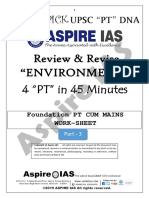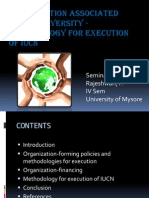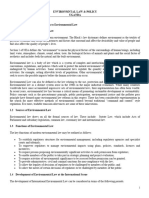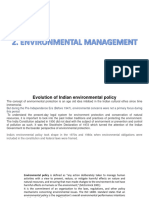22 N
22 N
Uploaded by
bartalusflora0Copyright:
Available Formats
22 N
22 N
Uploaded by
bartalusflora0Original Title
Copyright
Available Formats
Share this document
Did you find this document useful?
Is this content inappropriate?
Copyright:
Available Formats
22 N
22 N
Uploaded by
bartalusflora0Copyright:
Available Formats
CITES – the Convention on International Trade in Endangered Species of Wild Fauna
and Flora (1974). IUCN is a signatory party and the CITES secretariat was
originally lodged with IUCN.
Ramsar Convention – Convention on Wetlands of International Importance (1975). The
secretariat is still administered from IUCN's headquarters.
IUCN entered into an agreement with the United Nations Environment Programme UNEP
to provide regular reviews of world conservation. The income this generated,
combined with growing revenue via WWF, put the organisation on relatively sound
financial footing for the first time since 1948.
This period saw the beginning of a gradual change in IUCN's approach to
conservation in which it tried to become more appealing to the developing world.
The World Conservation Strategy 1975–1985
[7]: 132–165
In 1975 IUCN started work on the World Conservation Strategy (1980).[9] The
drafting process, and the discussions with the UN agencies involved, led to an
evolution in thinking within IUCN and growing acceptance of the fact that
conservation of nature by banning human presence no longer worked. The Strategy was
followed in 1982 by the World Charter for Nature, which was adopted by the United
Nations General Assembly, after preparation by IUCN.
In 1980, IUCN and WWF moved into shared new offices in Gland, Switzerland. This
marked a phase of closer cooperation with WWF, but the close ties between IUCN and
WWF were severed in 1985 when WWF decided to take control of its own field
projects, which so far had been run by IUCN.
Sustainable development and regionalisation: 1985 to present day[7]: 176–222
In 1982, IUCN set up a Conservation for Development Centre within its secretariat.
The Centre undertook projects to ensure that nature conservation was integrated in
development aid and in the economic policies of developing countries. Over the
years, it supported the development of national conservation strategies in 30
countries. Several European countries began to channel considerable amounts of
bilateral aid via IUCN's projects. Management of these projects was primarily done
by IUCN staff, often working from the new regional and country offices IUCN set up
around the world. This marked a shift within the organisation. Previously, the
volunteer Commissions had been very influential, now the Secretariat and its staff
began to play a more dominant role. In 1989, IUCN moved into a separate building in
Gland, close to the offices it had shared with WWF. Initially, the focus of power
was still with the Headquarters in Gland but the regional offices and regional
members' groups gradually got a bigger say in operations.
In 1991, IUCN (together with UNEP and WWF) published Caring for the Earth, a
successor to the World Conservation Strategy.[8]
Social aspects of conservation were now integrated in IUCN's work; at the General
Assembly in 1994 the IUCN mission was redrafted to its current wording to include
the equitable and ecologically use of natural resources.
Closer to business: 2000 to present day
Since the creation of IUCN in 1948, IUCN Members have passed more than 300
resolutions that include or focus on business related activities.
The increased attention on sustainable development as a means to protect nature
brought IUCN closer to the corporate sector. The members decided against this, but
IUCN did forge a partnership with the World Business Council for Sustainable
Development. IUCN renewed a multi-year MOU (Memorandum of understanding) with WBCSD
in December 2015.
In 1996, after decades of seeking to address specific business issues, IUCN's
Members asked for a comprehensive approach to engaging the business sector.
Resolution 1.81 of the IUCN World Conservation Congress held that year "urged IUCN
Members and the Director General, based on the need to influence private sector
policies in support of the Mission of IUCN, to expand dialogue and productive
relationships with the private sector and find new ways to interact with members of
the business community".
The IUCN Global Business and Biodiversity Program (BBP) was established in 2003 to
influence and support private partners in addressing environmental and social
issues.[10] In 2004, the first IUCN Private Sector Engagement Strategy was
developed (in response to Council Decision C/58/41). Most prominent in the Business
and Biodiversity Program is the five-year collaboration IUCN started with the
energy company Shell International in 2007.[11][12]
IUCN has been involved in minimum energy consumption and zero-carbon construction
since 2005 by integrating energy-saving materials, developed by Jean-Luc Sandoz in
the footsteps of Julius Natterer.[13]
Today, the Business and Biodiversity Programme continues to set the strategic
direction, coordinate IUCN's overall approach and provide institutional quality
assurance in all business engagements. The Programme ensures that the Business
Engagement Strategy is implemented through IUCN's global thematic and regional
programmes as well as helps guide the work of IUCN's six Commissions.
Championing Nature-based Solutions: 2009 to present day
Nature-based solutions (NbS) use ecosystems and the services they provide to
address societal challenges such as climate change, food security or natural
disasters.[14]
The emergence of the NbS concept in environmental sciences and nature conservation
contexts came as international organisations, such as IUCN and the World Bank,
searched for solutions to work with ecosystems rather than relying on conventional
engineering interventions (such as a seawall), to adapt to and mitigate climate
change effects, while improving sustainable livelihoods and protecting natural
ecosystems and biodiversity.
At the IUCN World Conservation Congress 2016, IUCN Members agreed on a definition
of nature-based solutions.[15] Members also called for governments to include
nature-based solutions in strategies to combat climate change.
Timeline
This section needs additional citations for verification. Please help improve this
article by adding citations to reliable sources in this section. Unsourced material
may be challenged and removed. (February 2022) (Learn how and when to remove this
message)
Some key dates in the growth and development of IUCN:
1948: International Union for the Protection of Nature (IUPN) established.[16]
1956: Name changed to the International Union for the Conservation of Nature and
Natural Resources (IUCN).
You might also like
- WBCSD TIP Sustainability Driven SDG Tire Sector RoadmapNo ratings yetWBCSD TIP Sustainability Driven SDG Tire Sector Roadmap49 pages
- Voluntary Guidelines for Sustainable Soil ManagementFrom EverandVoluntary Guidelines for Sustainable Soil ManagementNo ratings yet
- Upsc "PT" Dna Environment in 45 Min.: Easy To PICKNo ratings yetUpsc "PT" Dna Environment in 45 Min.: Easy To PICK46 pages
- Background Guide: Christ Academy Model United Nations 19th EDITIONNo ratings yetBackground Guide: Christ Academy Model United Nations 19th EDITION11 pages
- Easy To PICK Review & Revise "Environment" 4 "PT" in 45 MinutesNo ratings yetEasy To PICK Review & Revise "Environment" 4 "PT" in 45 Minutes46 pages
- Sustainable Development: Environmental Planning, Laws and Impact AssessmentNo ratings yetSustainable Development: Environmental Planning, Laws and Impact Assessment16 pages
- Bem4101 Introduction To Environmental Education Lesson Eleven-1No ratings yetBem4101 Introduction To Environmental Education Lesson Eleven-116 pages
- Unep and Unfcc: Prepared by Dr. Anup K MishraNo ratings yetUnep and Unfcc: Prepared by Dr. Anup K Mishra7 pages
- Organization Associated With Biodiversity Organization-Methodology For Execution IucnNo ratings yetOrganization Associated With Biodiversity Organization-Methodology For Execution Iucn45 pages
- International Union For Conservation of NatureNo ratings yetInternational Union For Conservation of Nature16 pages
- World Conservation Strategy IUCN-UNEP-WWF 1980 PDFNo ratings yetWorld Conservation Strategy IUCN-UNEP-WWF 1980 PDF77 pages
- Lecture 11 - International Convention Part 2No ratings yetLecture 11 - International Convention Part 2174 pages
- UNEP REPORT Rules of Engagement and Agenda OverviewNo ratings yetUNEP REPORT Rules of Engagement and Agenda Overview15 pages
- Environmental_Conservation_okgMLdvb1XN2U9PeNo ratings yetEnvironmental_Conservation_okgMLdvb1XN2U9Pe12 pages
- Short Notes On Various Environmental Protection Act - New TopicNo ratings yetShort Notes On Various Environmental Protection Act - New Topic5 pages
- Lec16 National and State Level Organizations - Environmental Laws and Acts - Environmental Education - CDMNo ratings yetLec16 National and State Level Organizations - Environmental Laws and Acts - Environmental Education - CDM13 pages
- WWF Contribution To The Thematic Report of The UN Special Rapporteur On Biodiversity and Human RightsNo ratings yetWWF Contribution To The Thematic Report of The UN Special Rapporteur On Biodiversity and Human Rights8 pages
- HAMUN Topic A&B Background Guide CombinedNo ratings yetHAMUN Topic A&B Background Guide Combined30 pages
- Lecture 10 - International Conventions Part 1No ratings yetLecture 10 - International Conventions Part 1175 pages
- Chapter 3 - Sustainable Development & Environmental IssuesNo ratings yetChapter 3 - Sustainable Development & Environmental Issues25 pages
- Concerns and Initiatives of The International Community On Sustainable Economic DevelopmentNo ratings yetConcerns and Initiatives of The International Community On Sustainable Economic Development5 pages
- Making Development Sustainable: Redefining Institutions Policy And EconomicsFrom EverandMaking Development Sustainable: Redefining Institutions Policy And EconomicsJohan HolmbergNo ratings yet
- Global Marine Biological Diversity: A Strategy For Building Conservation Into Decision MakingFrom EverandGlobal Marine Biological Diversity: A Strategy For Building Conservation Into Decision MakingNo ratings yet
- Forest-Based Adaptation: Transformational Adaptation through Forests and TreesFrom EverandForest-Based Adaptation: Transformational Adaptation through Forests and TreesNo ratings yet
- ADB Strategy 2030 Operational Plans-Overview-16sept2019No ratings yetADB Strategy 2030 Operational Plans-Overview-16sept201916 pages
- Sustainable Finance: An Insight Into The Recent Developments and Its Risk and OpportunitiesNo ratings yetSustainable Finance: An Insight Into The Recent Developments and Its Risk and Opportunities7 pages
- HSE Environmental Hazard Control Procedure 1674601317No ratings yetHSE Environmental Hazard Control Procedure 16746013176 pages
- DNV - Enhancing Organizational Resilience Through Integrated Risk ManagementNo ratings yetDNV - Enhancing Organizational Resilience Through Integrated Risk Management7 pages
- Economics Environmental Quality: Ms. Juilee Anil SawantNo ratings yetEconomics Environmental Quality: Ms. Juilee Anil Sawant11 pages
- Copy of Brosurr - 20231130 - 095857 - 0000No ratings yetCopy of Brosurr - 20231130 - 095857 - 00006 pages
- Sample Corporate Social Responsibility PolicyNo ratings yetSample Corporate Social Responsibility Policy2 pages
- Green Human Resource Management: A Report ONNo ratings yetGreen Human Resource Management: A Report ON21 pages
- Schedule Online Training QHSE 2022-Aljabar T&CNo ratings yetSchedule Online Training QHSE 2022-Aljabar T&C16 pages
- Responsible Leadership - Presentation SlidesNo ratings yetResponsible Leadership - Presentation Slides8 pages
- Total Safety Management (TSM) in Quality Management SettingNo ratings yetTotal Safety Management (TSM) in Quality Management Setting3 pages
- Sustainability Audit Checklist Sample Report SafetyCultureNo ratings yetSustainability Audit Checklist Sample Report SafetyCulture12 pages
- 2021 Sustainability F.PDF - Coredownload.inlineNo ratings yet2021 Sustainability F.PDF - Coredownload.inline84 pages

























































































